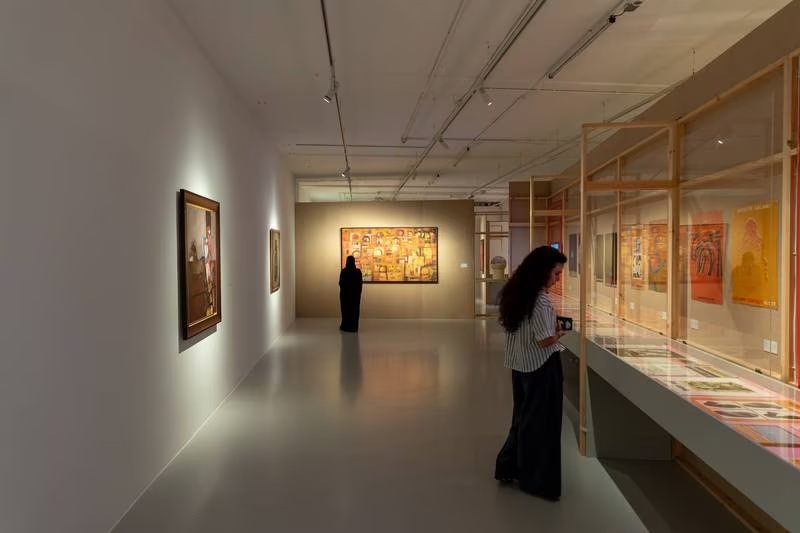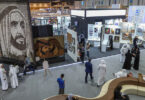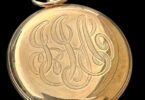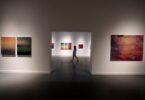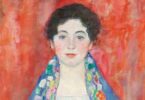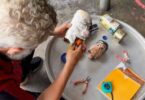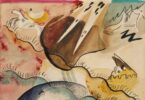Myrna Ayad
There’s a wistfulness in its name – Beirut and the Golden Sixties: A Manifesto of Fragility. It hearkens a nostalgia of an idyllic and bygone time, abruptly lost. It is with these sentiments that one approaches Sam Bardaouil and Till Fellrath’s exhibition, now running at Doha’s Mathaf: Arab Museum of Modern Art, after appearing at Berlin’s Gropius Bau and the Lyon Biennale last year.
The show has taken 230 loaned works by 34 artists and more than 300 archival documents from almost 30 collections around the world. Set between 1958 and 1975, the show charts the promise of an independent Lebanon, free from French colonial rule, across a period of social and economic prosperity, and chronicles malicious political tumours that led to the deadly Lebanese Civil War.
Why would Bardaouil and Fellrath, who are directors of Berlin’s Hamburger Bahnof, want to reflect on Beirut and its golden years? Why now? As Lebanon faces its worst economic and financial collapse due to decades of corruption, with 80 per cent of its population living below the poverty line, a devaluing currency and fractured sectarian politics, it’s almost impossible to imagine Lebanon ever having golden years.
Or as Zeina Arida, Mathaf’s director puts it: “If they were so golden, we would not have gone to war.” Perhaps the exhibition offers some answers about the present. “The ideological rifts that were evident in the art scene are only the tip of the iceberg,” says Bardaouil. “The consequences of the Lebanese Civil War are still at the root of many of the problems that we suffer from today.”
:quality(70)/cloudfront-eu-central-1.images.arcpublishing.com/thenational/CAZIXIRNP5DCPF6YDSXA6KBQ64.jpg)
An idea manifests
It makes sense for Beirut and the Golden Sixtiesto end its expedition in Doha. For a start, many showcased artists are represented in Mathaf, which has one of the world’s finest collections of modern Arab art. Eye-opening as it was for European audiences, Arab visitors will also make many a discovery.
“I enjoy exhibitions that allow me to learn about new things and this show does that. We forget race, religion and geography and remember that we have a rich culture and incredible art,” says Abraham Karabajakian, a Beirut collector who lent the show several artworks. “We must continue to stage such exhibitions because in so doing, we keep our art on the map and hopefully tempt nationals and tourists to visit Lebanon.”
The show was abstractly conceived in 2017 when Bardaouil and Fellrath were working on Witness to a Golden Age, an online platform for Lebanon’s Saradar Foundation that charts art spaces in Beirut in the 1960s and 1970s.
Their research uncovered thousands of archival documents. It was a story waiting to be told, or rather, resurrected. Among the first individuals they discussed the concept with was Arida, who was then director of Sursock Museum, one of the show’s institutional lenders. It was then enmeshed in a massive restoration project post-Beirut’s devastating August 2020 port blast that damaged the museum.
Beirut and the Golden Sixties was the first show that Arida programmed when she was appointed director of Mathaf in November 2021. “In the Arab world, we don’t have institutions that really practice the act of looking back to understand why we are where we are,” Arida says.
Seventeen years in five chapters
Alongside masterful scenography and navigational ease, a sense of wistfulness is palpable across five thematic galleries whose paintings and sculptures sit against blown-up, old, grainy images of Beirut. A healthy dose of archival material is scattered in birch-coloured cases and structures. One would be forgiven for assuming that the predominance of unfinished wood evokes a sense of incompleteness. Perhaps like the material, this is a fragmentary story after all.
:quality(70)/cloudfront-eu-central-1.images.arcpublishing.com/thenational/Z6ETTPOPNRDDVLWYBDCY467MR4.jpg)
It begins with Le Port de Beyrouth (The Port of Beirut): The Place, a metaphoric and literal name illustrating the city’s very entry point and named after a featured 1954 work by Egyptian master Mahmoud Said. The vista tells of Beirut’s bustling economy, a flurry of imports and exports, and those who came from across the Arab world and beyond. It also discloses a city of excess and exuberance, and reflects on Beirut’s social underbelly, exposing its gaps and divides.
The disparities are highlighted in Paul Guiragossian’s paintings of Armenian refugee camps and Rafic Charaf’s impoverished Beqaa Valley. We proceed to Lovers: The Body, named after a 1963 painting by Jordanian artist Mona Saudi loaned from Sharjah’s Barjeel Art Foundation.
It is an intimate gallery, featuring Huguette Caland’s abstract paintings, Juliana Seraphim’s surreal drawings, Helen Khal’s 1970s portraits and Dorothy Salhab Kazemi’s stoneware and glaze works.
:quality(70)/cloudfront-eu-central-1.images.arcpublishing.com/thenational/7DZNOWAG3BET7ERYVUCYQVGULM.jpg)
Lovers tells of a city where artists found the freedom to experiment and express themselves. Takween (Composition): The Form takes its name from Iraqi artist Hashim Samarchi’s 1972 op art painting. There’s a stunning display of sculptures by the Arab world’s mother of abstraction, Saloua Raouda Choucair, and some dazzling avant-garde Perspex sculptures by John Hadidian, who, like Choucair, had a sincere orientation towards architecture.
In Takween, visitors encounter artists who practised a wide variety of modernist tendencies and media, who identified with philosophies that extended beyond the borders of Lebanon or the Arab world: simply, they believed in concepts, regardless of culture or geopolitics.
Things get darker in Monster and Child: The Politics. Beirut howls with outrage with powerful reactions to the 1967 Six Day War from Aref El Rayess and Shafic Abboud; a collective grief in Gamal Abdel Nasser’s death through a Guiragossian masterpiece depicting the funeral of the former Egyptian president; aching sorrow towards Palestine in Charaf’s melancholic painting Palestinian Woman; and Jumana El Husseini’s sweet landscapes of her native Jerusalem.
The archival material is charged, too, with exhibition posters furiously responding to the region’s politics. And therein lies the crux of this gallery: Beirut absorbed all the region’s problems in addition to its own. With Lebanon a site of regional tug-of-war, a proxy battleground for others, and with its domestic matters in disarray, an eruption was inevitable. Monster and Child: The Politics, named after a featured work by Fateh Moudarres loaned by the Atassi Foundation for Arts and Culture, is akin to a ticking bomb.
:quality(70)/cloudfront-eu-central-1.images.arcpublishing.com/thenational/X7LNY7DCEBHXXJ347YRSSAYBEU.jpg)
The proverbial bomb explodes in Blood of the Phoenix: The War, and with war comes division. The adage “one man’s freedom fighter is another man’s terrorist” is exemplified in Georges Doche’s portraits of warriors, whose details demonstrate the Egyptian artist’s mastery of jewellery and costume design. These warriors were the 1970s godfathers and reappear in works by Simone Fattal and El Rayess.
A first glance at Cici Sursock’s paintings suggests Christian iconography, but closer inspection reveals sinister details. Where Le Port de Beyrouth (The Port of Beirut): The Place acts as an entry, Blood of the Phoenix: The War presents an exit, and it is here, where, against Jamil Molaeb’s poignant and painful visual diary, Civil War Notebook, an exodus is happening and the Beirut art scene as we knew it, is undone.
Poetic endings
Civil war is uncivil, and untreated cancer will metastasize. This helps explain the shocking, tear-jerking content in Joana Hadjithomas and Khalil Joreige’s circle of 14 televisions: CCTV footage of Sursock Museum the moment the August 4 blast detonated. This, 45 years after Beirut’s golden ’60s, confirms that neglected issues festered.
The Lebanese duo’s second work, But my head is still singing, is the exhibition’s only commission and clinches the show poetically and metaphorically. It takes inspiration from the ancient Greek love story of Orpheus, a talented lyre player with a melodious voice, and the nymph Eurydice, whose union is doomed with her death. Sick with grief, Orpheus goes to the underworld to bring back his wife, but fails.
While singing a mourning song and asking for death so that he may be reunited with Eurydice, Orpheus is killed but his head remains intact and continues to sing. Like Beirut, despite the violence, it endured and continues to sing. Or so one hopes.
Courtesy: thenationalnews

